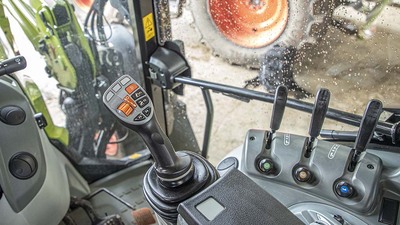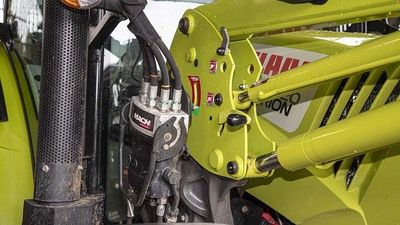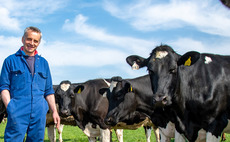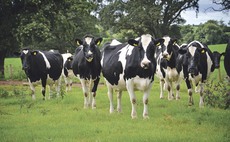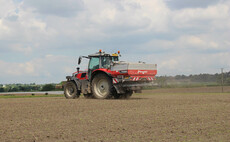
Looking for a more capable loader tractor with greater visibility to suit traditional livestock buildings, one Somerset farm opted for Claas' Arion 400 Series, complete with panoramic cab option. Geoff Ashcroft reports.
As loader tractors have evolved, forward visibility has become an area that can be easily overlooked in favour of operator comfort and convenience. But for Somerset farmer Simon Dyke, extra visibility moved to the top of his wish list as a must-have for his latest loader tractor purchase.
Based at the 80-hectare Burnt House Farm in the Mendip hills near Waterlip, Shepton Mallet, Mr Dyke runs an organic sucker herd, comprising 220-head with followers.
The farm is predominantly grass leys and clover, with wholecrop included to boost forage quality, taking away the need for concentrate feeding.
Mr Dyke says; "We have just enough kit to carry out all the prepwork for silage, haylage and haymaking, so we get the quality right.
"We do produce a lot of bales, in addition to clamp silage. We cannot justify a telehandler, so a tractor-loader has to be a jack of all trades."
Until last year, he had been using a four-cylinder 100hp Claas Axos 340 with a loader, alongside a six-cylinder Arion 620.
Both have their roles, with the larger Arion suiting heavier work including ploughing and cultivations, while the Axos took care of loading, plus mowing, raking and tedding.
However, the smaller tractor could also find itself on a three-metre power harrow. "The Axos was alright," explains Mr Dyke.
Reliable
"Though reliable, it was perhaps just a touch too basic. Visibility to the loader was a compromise, particularly when filling barns, and its manual transmission sometimes demanded a lot of effort on trailer duties. I needed to ditch the gear lever.
"All this clarified that the replacement tractor would be one that provided much better visibility for loader work, and come with a more sophisticated transmission," he says.
"We are in the Mendip Hills, so speed matching and auto shifting were going to be sensible improvements."
With good back-up and support from his local dealer, Claas Western at Frome, the German marque was the obvious choice.
And a step-up to the Arion 400 Series would bring the operator comfort and convenience he sought, along with the improved visibility he craved but without going to a much larger tractor.
This is because when the Arion 400 Series was updated in 2015, it came with a number of new options, including a panoramic cab option giving 90 degrees of unobstructed forward and upward views. Ideal then for loader duties.
It also ditched the Deere Power Systems engine in favour of an FPT motor, and brought selective catalytic reduction to the mix, requiring a slurp of diesel exhaust fluid to meet Stage 4 emissions.
"I opted for an Arion 420 Panoramic with Quadrishift transmission and FL100 loader," he adds.
"I did not want a much bigger tractor as it still needed to work in and around buildings, so manoeuvrability and size were important. So I stuck with 100hp, but with the benefit of improved vision to make loader duties safer and more productive.
"It is also my first tractor with AdBlue, though that aspect has not been an issue to me," he adds.
"Fortunately, service intervals have been increased from 500 to 600 hours, which helps with lowering running costs." Being prudent with finances, Mr Dyke had to make some sacrifices in specification, to stay within his budget.
This meant favouring the panoramic cab over front axle suspension, though the Claas-branded MX loader came with boom suspension and multi-coupler to simplify getting the loader on and off the tractor.
He also added a lighting package too, improving illumination in winter for stock duties around the yard.
"I had a Deere in the past, but the increased purchase price stopped me going back again," he says.
"The Claas Arion 420 was much better value for money, and based on the trade-in value of my Axos, it should be more cost-effective to keep during my ownership.
While I would like to swap a tractor when the warranty runs out, I also need to be sure that reliability is good too," says Mr Dyke.
"The Axos left after six years and around 4,000 hours, and it had proved a robust and reliable tractor, and the support I have had from Claas Western has been great."
A year into Arion 420 ownership, Mr Dyke has nothing but praise for the panoramic cab. "I do not find myself leaning forward in the seat to see when I am placing loads at full height," he says.
Innovation
"It is a great innovation. And with a sun blind built into the roof, I can block out light when I do not need it."
Keeping the perspex roof window clean calls for a long-handled brush to wash the surface, with a useful step on the diesel tank allowing the surface to be wiped dry.
"Where my old loader tractor had a separate joystick on the right-hand console, this new model has a joystick built into the armrest. It has much better integration and is a far better fit," he adds.
"And it offers full transmission control, rear linkage and also loader control, all on the same lever. It is just so handy.
"Being able to flick through four powershifts and four ranges, all on the joystick, is superb." Though, he says perhaps the tractor's biggest drawback is fuel tank capacity.
"The Arion 620 will do a day's work on a tank, where the Arion 420's tank is almost half the size," he says.
"It is not that the tractor is particularly thirsty, it is just that a 140-litre tank is small. A 430 model gets 190 litres.
If I am working flat out on cultivations, it will not last a day." He says that while it is easy to get the loader on and off, swapping attachments has got harder.
"The larger bonnet has made it less straightforward to swap attachments," he says.
"But you soon work out a technique that suits. For me, it is looking down the outside of the loader and tilting the carriage right over to hook the attachment."
Unusually, he has done a lot of road work with the tractor this summer and admits that front axle suspension and a 50kph transmission would have been beneficial.
He says: These are nice items to have, but for the few occasions I needed them, their add-on cost still tells me the specification I chose was right for me. I do not want to be a slave to finance. The costs have to be sensible and affordable."
Mr Dyke covers about 800 hours/year with his Arion 420 and 600 hours/year with the larger Arion 620.
"They both have their own jobs and both have a place on the farm," he adds.
"I could not do everything with one tractor. This way I can spread the risk with reliability, should one of them ever let me down. And that is also important when I am out lending a hand with neighbours."

